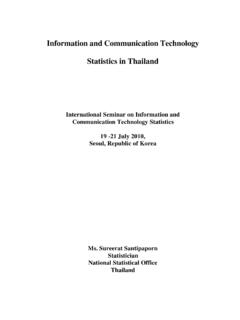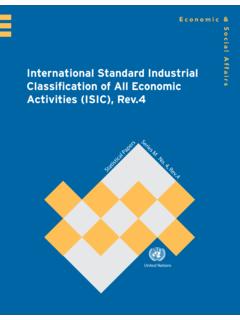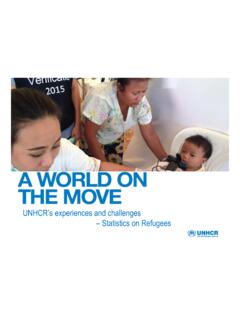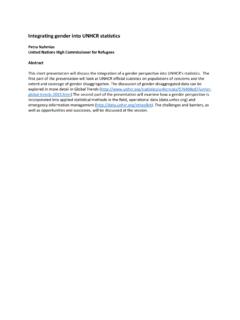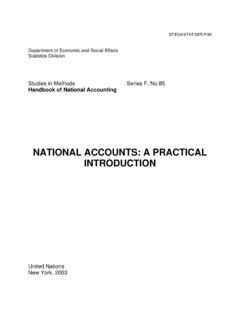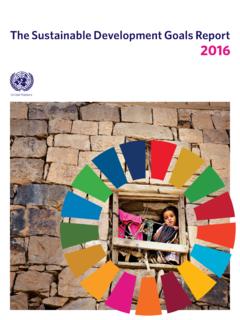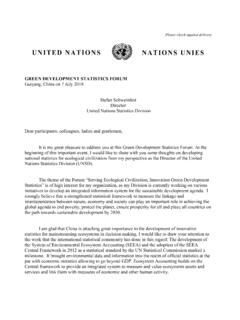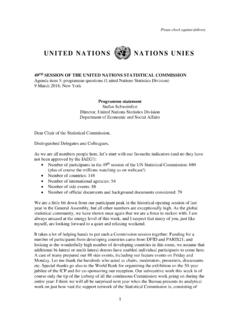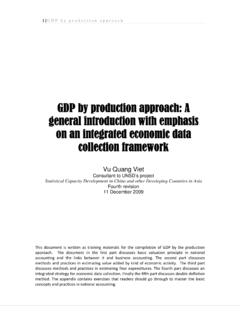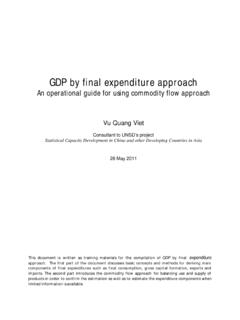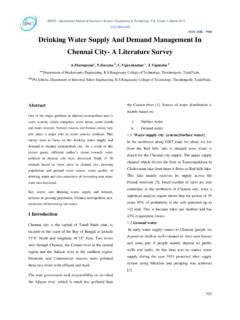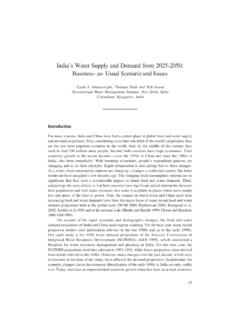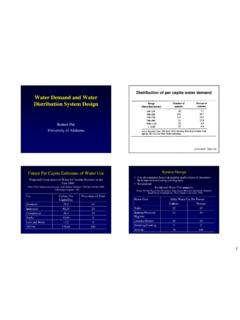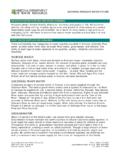Transcription of Water supply and water use statistics in Jordan - UNSD
1 IWG-Env, International Work Session on Water statistics , Vienna, June 20-22 2005. Water supply and Water use statistics in Jordan Khamis Raddad Department of statistics Jordan 1. Introduction The scarcity of Water resources is one of the main challenges for Jordan and a limiting factor for economic development especially for agriculture. The demand on Water resources is increasing with time for both agriculture and non-agricultural purposes. Jordan receives rainfall of about 6,000 million cubic meters (MCM), and the Syrian catchment of the Yarmouk River Basin receives an additional 2,065 MCM.
2 High evaporation and infiltration results in a relatively small annual stream flow of about 878. MCM, excluding Jordan River flow. The potential for further development of surface Water resources rests principally with the construction of the proposed Al Wehdeh Dam on the Yarmouk River. This dam would provide an annual safe yield of about 105 MCM, of which 55 MCM for manufacturing and industrial uses in Irbid region. The remaining 50 MCM would be used to intensify agricultural production in the Jordan Valley. In addition to the overall constraints of this resource, there are other problems which limit its large scale usage for irrigation purposes.
3 One of the most significant problems is the exceeding of the safety limits which leads to the depletion of fresh Water resources and an increased salinity of Water . Other problems include the growing costs of Water pollution and excessive pumping of groundwater especially in the highlands the Dheleil and Azraq basins. Jordan is considered among the poorest countries in the world in terms of Water resources. The climate is generally arid, with more than 90% of Jordan 's total area receiving less than 200 millimeters rainfall per year and more than 70% of the country receiving less than 100 millimeters of precipitation on a year.
4 Only around 2% of the land area, located in the north-western highlands, has an annual precipitation exceeding 300. millimeters. The northern highlands may receive as much as 600 millimeters. About of Jordan 's area is considered dry land with annual rainfall ranging from 200 to 300. millimeters. The pattern of rainfall is characterized by an uneven distribution over the various regions, and strong fluctuation from year to year in terms of quantity and timing. Jordan is characterized by a pronounced scarcity of renewable fresh Water resources, which averages at about 680 MCM per year, or approximately 135 m3 per capita for all uses.
5 Thus, Jordan 's Water resources are, on a per capita basis, among the lowest in the world. The Water resources of Jordan consist of groundwater and fossil Water which are found in aquifers at different depths throughout Jordan . Other sources of Water include surface Water flows from precipitation in the Jordan River Basin, increasing treated waste Water as well as non-conventional Water resources such as brackish Water . 1. IWG-Env, International Work Session on Water statistics , Vienna, June 20-22 2005. 2. Water supply Surface Water supply The main supplier of Water in Jordan is the public sector.
6 The public sector provides the agriculture holders in Jordan valley with surface Water for irrigation purposes. The Jordan Valley Authority (JVA) is the government agency in the Jordan Valley, and has established an irrigation network system to serve more than 31,174 ha of fertile valley land on Jordan 's western border, an area which makes a significant contribution to the total tonnage of fruit and vegetables produced in Jordan . The annual supply of surface Water is MCM, with the Jordan Rift Valley contributing 108 MCM. Springs account for MCM and base flows and floods account for MCM.
7 Most of the surface Water ( ) is allocated for agricultural activity, with about 152 MCM allocated for the purpose of irrigation. Most surface Water used for irrigation is used in the Jordan Valley. In addition, all treated waste Water for irrigation purposes is mixed with fresh Water to ensure dilution of pollutants from the treated Water . The total quantity of treated Water is MCM. The government also supplies Water for municipal use (this includes households and some economic activities like service activities). The total quantity of surface Water allocated for this purpose is MCM, with industrial activity using about MCM.
8 Table 1: Quantity (MCM) of surface Water use by Water resource 2004.*. Source Livestock Irrigation Industrial Municipal Total 1. Surface Water - Jordan Rift Valley - Springs - Base & Flood 2. Treated Waste Water - Registered - Not Registered Total *Source: Authority Treated Water contributes more than one fourth of what is contributed by surface Water (Table 1). This contribution is quite high and can be attributed to the scarcity of Water resources in Jordan . It is very important to make sure there is quality control of treated Water before it is used for irrigation purposes. Ground Water supply Ground Water is abstracted by both public and private sectors.
9 Most agriculture holders abstract Water for their own use directly which is considered self supply . The government is trying to monitor the quantity of ground Water abstracted by the private sector including agriculture. The government abstracts ground Water for purposes other than agriculture. The mining industry also abstracts ground Water for their own use. 2. IWG-Env, International Work Session on Water statistics , Vienna, June 20-22 2005. The total quantity of ground Water is 520 MCM. The agricultural sector uses about 54%. of ground Water . The municipal sector uses about 40% of ground Water , and the remaining (6%) is used for industrial activity.
10 Table 2: 2004 Ground Water use in MCM.*. Source Livestock Irrigation Industrial Municipal Total 2. Ground Water - Renewable - Non-Renewable *Source: Authority It is important to note that the current use of ground Water exceeds available renewable supplies, and non-renewable Water is being abstracted. Jordan covers the increasing deficit through over drafting of highland aquifers and exploitation of non-renewable groundwater. In 2004, the over drafting of groundwater resources exceeded 230 MCM. The depletion of ground Water varies from one ground Water basin to another. In some basins the over pumping of ground Water exceeds by 3 times the safe yield, on the other hand the abstraction of Water from other basins can be much less than the safe yield.
